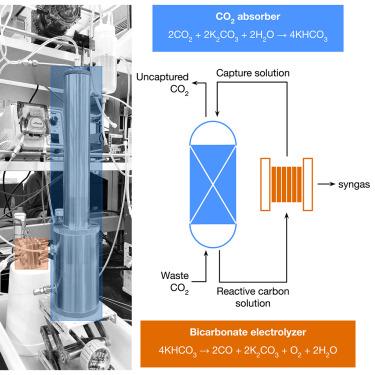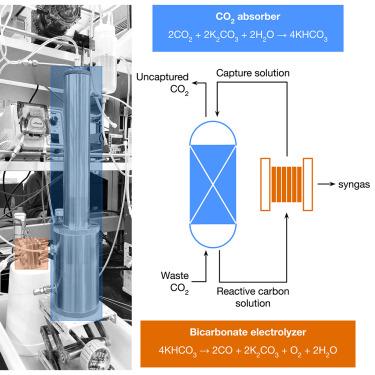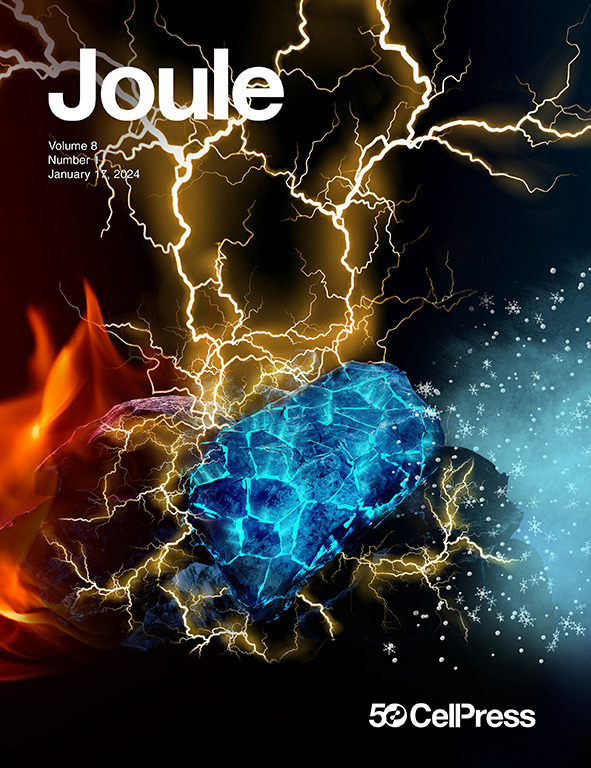综合二氧化碳捕获和转化为合成气
IF 35.4
1区 材料科学
Q1 CHEMISTRY, PHYSICAL
引用次数: 0
摘要
要将废弃的二氧化碳(CO2)转化为有价值的化学品和燃料,电解槽必须与上游的二氧化碳捕集步骤相结合。然而,由于二氧化碳捕获和转化率不匹配,这种整合尚未得到证实。我们介绍了一种二氧化碳捕集-转化集成系统,该系统在稳定状态下产生的合成气中,H2 与 CO 的比例为 1.7:1,捕集率与电解槽中的释放率相匹配。该系统采用填料床吸收器,其中 K2CO3 溶液与模拟烟气中的 CO2 反应生成富含(双)碳酸盐的溶液,然后将其送入电解槽生成 CO 和 OH-。碱性产物再循环到吸收器,完成二氧化碳捕获-转化循环。利用甘氨酸作为二氧化碳捕获促进剂,该系统可从模拟烟气中捕获 30% 的碳,在 100 mA cm-2 的条件下,30 小时内二氧化碳转化为 CO 的法拉第效率为 30%。本文章由计算机程序翻译,如有差异,请以英文原文为准。


Integrated CO2 capture and conversion to form syngas
To convert waste carbon dioxide (CO2) into valuable chemicals and fuels, electrolyzers must be integrated with an upstream CO2 capture step. However, this integration has not been demonstrated due to the mismatched rates between CO2 capture and conversion. We present an integrated CO2 capture-conversion system that produces syngas with a 1.7:1 H2 to CO ratio at steady state, where the capture rate matches the release rate in the electrolyzer. The system uses a packed-bed absorber where K2CO3 solutions react with CO2 from simulated flue gas to form (bi)carbonate-enriched solutions, which are then fed into an electrolyzer to produce CO and OH−. The alkaline product is recycled to the absorber, completing the CO2 capture-conversion loop. With glycine as a CO2 capture promoter, the system captures 30% of carbon from simulated flue gas with a Faradaic efficiency of 30% for CO2 conversion to CO at 100 mA cm−2 over 30 h.
求助全文
通过发布文献求助,成功后即可免费获取论文全文。
去求助
来源期刊

Joule
Energy-General Energy
CiteScore
53.10
自引率
2.00%
发文量
198
期刊介绍:
Joule is a sister journal to Cell that focuses on research, analysis, and ideas related to sustainable energy. It aims to address the global challenge of the need for more sustainable energy solutions. Joule is a forward-looking journal that bridges disciplines and scales of energy research. It connects researchers and analysts working on scientific, technical, economic, policy, and social challenges related to sustainable energy. The journal covers a wide range of energy research, from fundamental laboratory studies on energy conversion and storage to global-level analysis. Joule aims to highlight and amplify the implications, challenges, and opportunities of novel energy research for different groups in the field.
 求助内容:
求助内容: 应助结果提醒方式:
应助结果提醒方式:


